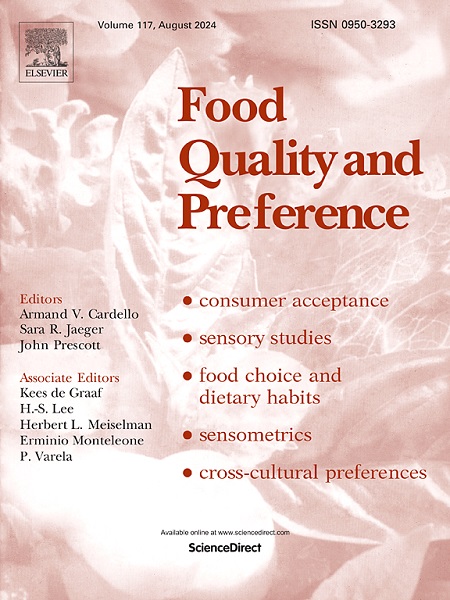探索以乳制品为基础的混合产品的偏好和情感反应:使用不同健康导向集群的以消费者为中心的发展的见解
IF 4.9
1区 农林科学
Q1 FOOD SCIENCE & TECHNOLOGY
引用次数: 0
摘要
这项研究开发并验证了一种混合乳制品,其中部分牛奶被植物性替代品所取代。共同创造阶段包括一项在线调查(n = 535名参与者),该调查根据他们对健康饮食的普遍兴趣确定了两个不同的消费者群体。第1类消费者主要是健康问题较低、更喜欢牛奶含量较高的产品的年轻人,而第2类消费者则是有健康意识的消费者,他们对饮食有更强的认识,更愿意减少产品中的牛奶含量。酸奶和冰淇淋是混合产品开发中最受欢迎的类别,而乳制品饮料和牛奶替代品则是最不受欢迎的。椰子和腰果是最受欢迎的植物性成分。此外,消费者优先考虑合格的营养声明,如“高蛋白含量”、“富含纤维”和“强化维生素和矿物质”,而“低脂肪”和“低糖”等声明则不太受重视。基于这些见解,混合酸奶被配制成五种变体,包括不同比例的牛奶和椰子基牛奶替代品。感官分析(n = 158名参与者)显示,牛奶含量较高的样品获得了更高的喜欢分数,并且主要引起了积极的情绪,如“满意”和“惊喜”,这是由情绪的时间优势(TDE)测量的。相反,含有较高比例椰子奶替代品的配方与更多的中性和负面情绪相关,如“不愉快的惊讶”和“温和”,并且表现出较低的喜欢得分。在消费者驱动型混合乳制品的开发中,将共同创造与感官验证相结合证明是成功的。本文章由计算机程序翻译,如有差异,请以英文原文为准。
Exploring preferences and emotional responses of a dairy-based hybrid product: insights from consumer-centric development using different health-oriented clusters
This study developed and validated a hybrid dairy product in which part of the milk was replaced with a plant-based alternative. The co-creation phase involved an online survey (n = 535 participants), which identified two distinct consumer clusters based on their general interest in healthy eating. Cluster 1 primarily comprised young individuals with lower health concerns and a greater preference for products with a higher milk content, whereas Cluster 2 consisted of health-conscious consumers with greater dietary awareness and a higher willingness to reduce milk content in products. Yogurts and ice creams were the most preferred categories for hybrid product development, while dairy beverages and milk substitutes were the least desired. Coconut and cashew nuts were the most preferred plant-based ingredients. Additionally, consumers prioritized qualified nutritional claims such as “high protein content,” “rich in fiber,” and “fortified with vitamins and minerals,” while claims such as “low fat” and “low sugar” were less valued. Based on these insights, a hybrid yogurt was formulated in five variations, incorporating different proportions of milk and a coconut-based milk alternative. Sensory analysis (n = 158 participants) revealed that samples with a higher milk content received higher liking scores and predominantly evoked positive emotions, such as “Satisfied” and “Pleasantly Surprised,” as measured by Temporal Dominance of Emotions (TDE). Conversely, formulations with a higher proportion of the coconut-based milk alternative were associated with more neutral and negative emotions, such as “Unpleasantly Surprised” and “Mild,” and demonstrated lower liking scores. The integration of co-creation with sensory validation proved successful in the development of a consumer-driven hybrid dairy product.
求助全文
通过发布文献求助,成功后即可免费获取论文全文。
去求助
来源期刊

Food Quality and Preference
工程技术-食品科技
CiteScore
10.40
自引率
15.10%
发文量
263
审稿时长
38 days
期刊介绍:
Food Quality and Preference is a journal devoted to sensory, consumer and behavioural research in food and non-food products. It publishes original research, critical reviews, and short communications in sensory and consumer science, and sensometrics. In addition, the journal publishes special invited issues on important timely topics and from relevant conferences. These are aimed at bridging the gap between research and application, bringing together authors and readers in consumer and market research, sensory science, sensometrics and sensory evaluation, nutrition and food choice, as well as food research, product development and sensory quality assurance. Submissions to Food Quality and Preference are limited to papers that include some form of human measurement; papers that are limited to physical/chemical measures or the routine application of sensory, consumer or econometric analysis will not be considered unless they specifically make a novel scientific contribution in line with the journal''s coverage as outlined below.
 求助内容:
求助内容: 应助结果提醒方式:
应助结果提醒方式:


